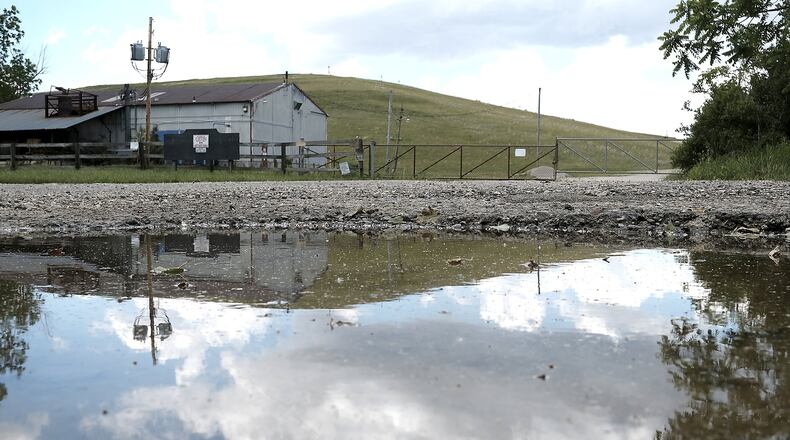Some residents have voiced concerns over the years regarding the possibility that toxic chemicals in the barrel fill could seep out and contaminate local drinking water.
The barrel fill contains hundreds of thousands of gallons of hazardous waste near a large drinking water source.
The area of concern is located at 3108 Snyder Domer Road and is a 8.5-acre section of a closed landfill that had been used for industrial waste barrels. It is located near an aquifer that provides drinking water for tens of thousands of area residents.
Officially listed as the Tremont City Barrel Fill Site by the U.S. Environmental Protection Agency, it is a closed industrial waste landfill in German Township and is about 1.5 miles west of Tremont City and about 3.5 miles northwest of Springfield.
The site covers a 8.5 acres on the northwest corner of a larger, 80-acre property that also includes the Tremont City Landfill and the Tremont City Waste Transfer Facility. About 51,500 drums and about 300,000 gallons of industrial liquid waste were disposed of in waste cells at the site between 1976 and 1979.
That information was listed on U.S. EPA’s website as the barrel fill is being addressed under that agency’s Superfund alternative approach.
The chemical waste at the Tremont Barrel Fill has not contaminated the source of local drinking water. But the concern is that waste, if not removed, can seep into the water supply in the future causing major complications.
“The infrastructure bill is law. We are going to spend trillions of our tax dollars. I say we spend it to clean up the barrel fill now before there is no remedy possible,” Koehler said.
His proposal comes at a time when local officials have become frustrated over a prolonged delay in the implementation of a current cleanup proposal regarding the barrel fill site.
The process of getting toxic waste removed at the barrel fill site has been in a state of limbo since 2019 as a consent agreement needs to be signed by the parties that will be responsible for an already proposed cleanup plan.
Companies involved in those talks have been identified as responsible parties in terms of cleaning up the waste.
The consent agreement, if agreed upon by those companies listed as the responsible parties, would allow the process to move forward as well as the development of more detailed cleanup plans. That would include the removal of liquid toxic waste from the site in Clark County and the remaining solid toxic waste would be reburied in a double-lined pit. That location would then be capped and nearby ground water would be monitored to detect any leaks.
However, Springfield City Commissioner David Estrop said that a federal consent agreement with a group of companies that would be responsible for the financing of the more than $20 million proposed cleanup has yet to be signed.
The current proposed cleanup plan at the heart of those talks was facilitated in part by the U.S. EPA, which would also manage its implementation.
Credit: Bill Lackey
Credit: Bill Lackey
“(The) EPA and the U.S. Department of Justice are actively engaging with the potentially responsible parties in an attempt to negotiate an agreement that will address the contamination. If an agreement is reached, it will be presented to a federal judge for review and entry. The cleanup process, which will include a design and construction of the landfill, can begin after these steps take place,” the U.S. EPA wrote on its website regarding the Tremont Barrel Fill.
However, Estrop, along with the local group, People for Safe Water, believe some of the parties responsible for the cleanup are holding up the process. That served as motivation in September when a contract for trash pick up services in Springfield with the company Waste Management was voted down by some city commissioners.
A representative of Waste Management denied that their company nor its indirect, wholly owned subsidiary Chemical Waste Management, was responsible for any delay in the process.
Mia Jankowiak, a communications manager at Waste Management, said that Chemical Waste Management is a member of the group of companies that “continues to actively work with the U.S. EPA to finalize the documents that will allow the companies to proceed with U.S. EPA’s selected remedy.”
However, Koehler feels that the process is taking too long and hopes that his proposal will allow for the access of federal dollars that will support the removal of all toxic chemicals at the Tremont Barrel Fill and not just liquids.
He hopes if his plan goes through, it would allow for the cleanup to start much sooner than the current proposal facilitated by the U.S. EPA.
But, Estrop voiced some concerns regarding the proposal, including if a project to cleanup the barrel fill would fit the guidelines regarding how money from the federal infrastructure bill is to be used.
Estop added that he also does not want to take responsibility away from the companies that are connected, directly or indirectly, to the chemical waste at the barrel fill.
The federal infrastructure bill focuses on a number of infrastructure projects and funding will be distributed in a number of different ways.
Estrop said if Koehler’s proposal does gain traction, he would encourage the City of Springfield to support it.
Koehler said that “while it is my hope that the US Justice Department does eventually hold those responsible liable for the chemicals buried just north of our city, my main concern is for cleaning up the toxic chemicals before they cause a problem that can never be fixed in court or with any amount of money.”
Clark County Commissioner Rick Lohnes said that due to the uncertainty of when a consent agreement would be reached regarding the current proposed Tremont Barrel Fill cleanup, it makes sense to look at other options.
Lohnes said he supports, along with his fellow commissioners, Koehler’s proposal to lobby those in congress that represent Clark County to see if federal funds can be used for the cleanup.
President Joe Biden in November signed the five-year bipartisan Infrastructure Investment and Jobs Act in a White House ceremony that included U.S. Sen. Rob Portman, R-Ohio, who was lead negotiator for his party in the senate.
The law funds roads and bridges; sewer and water systems, including removal of lead drinking water lines; public transit; airports; ports; expanded broadband internet access; an electric vehicle charger network; electric grid improvements; solar, wind and other clean energy technology; weatherization programs; pollution mitigation; cyberattack protection; wildfire protection and making infrastructure more resilient to extreme weather, this new organization previously reported.
The bipartisan infrastructure deal also plans on delivering a large investment in “tackling legacy pollution in American history by cleaning up Superfund and brownfield sites, reclaiming abandoned mines, and capping orphaned oil and gas wells,” said a fact sheet regarding the infrastructure bill that was posted on the White House’s official website.
The bill plans to invest $21 billion to clean up Superfund and brownfield sites, reclaim abandoned mine land, and cap orphaned oil and gas wells, stated the fact sheet.
Koehler said he hopes his proposal related to the Tremont Barrel Fill site will lead to the lobbying of some of the funds that have been set aside for those clean up projects. He said that he is hopeful that the Tremont Barrel Fill will meet federal guidelines associated with the use of those dollars.
About the Author


